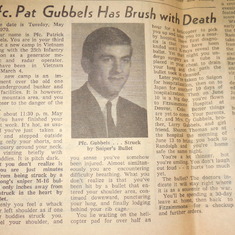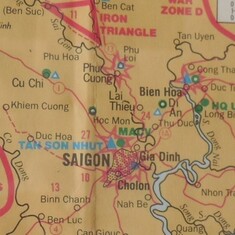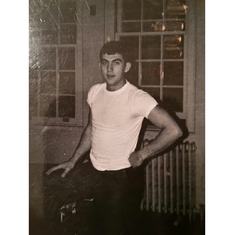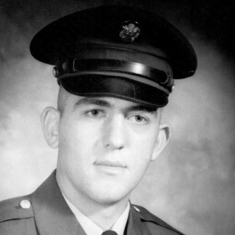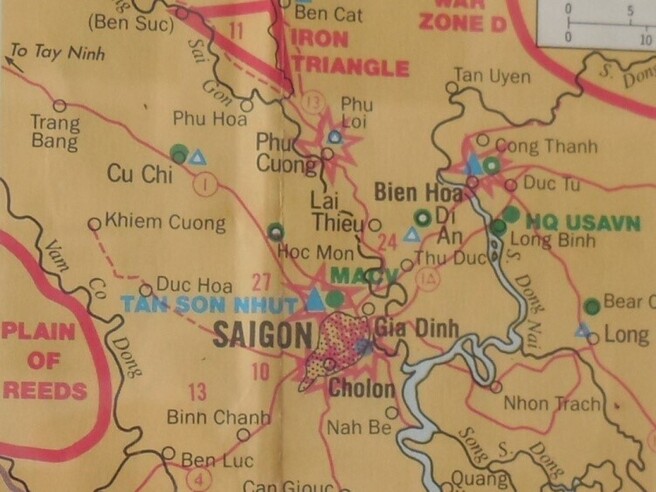Pat's Vietnam Experience
.
Pat R. Gubbels
25th Infantry Division-Artillery
September 1969-April 1971
I met Pat one evening in December 1973 in a local bar where he and an Army buddy had been "reliving Nam" since early that morning. After that evening, we started dating. We had been dating for a short time when we decided to go to the movie "Walking Tall". I noticed during the movie, especially during scenes where there was gunfire and other forms of violence, that Pat started sweating profusely and squirming in his seat. He told me after the movie that it reminded him of Vietnam. Initially, he didn't talk to me about his experiences in Vietnam other than to warn me that if he was ever sleeping in my presence, I should not touch him because he was afraid he would "come up fighting". Over the years Pat has gradually shared more about his experiences and about the emotions of being a "forgotten" soldier. He also gradually was unconditioned to wake up fighting for his life.
This biographical sketch is, in a sense, a reliving of Pat's experiences in Vietnam because I believe it is important to tell his story so it will serve as a personal history for his sons and their families and future generations.
Pat enlisted in the US Army a few months (September 24, 1969) after graduating from St Francis Catholic High School in Randolph, NE. He believed it was his patriotic duty to serve his country. After completing basic training at Fort Polk, LA he was promoted from E1 to E2 at the completion of basic training. He then completed Advanced Infantry Training (Counter battery/Counter mortar Radar Crewman training) at Fort Sill, OK before being sent to Vietnam March 4, 1970. Pat arrived in Saigon and was then positioned at Cu Chi, home of the 25th Infantry, as a forward observer. Forward observers are typically artillery soldiers who has been trained in the techniques of observation. Sometimes FOs are called spotters because they are the eyes on the ground who spot targets, determine if artillery or bombs land on the targets, and make the necessary adjustments or calls in the corrections needed to hit targets. As a radar operator and generator mechanic, Pat's job was to determine where all of the US patrols were located and to find enemy forces that were trying to infiltrate artillery bases or waiting in ambush for the platoons that were on search and destroy missions
.
Pat was part of a team of five forward observers who were dispersed to live with the ARVN (Army of the Vietnamese Republic). For example, he spent time in the local village of Trang Bang.
On May 21, 1970 Pat and his team had relocated to a new camp that was an improvement over the previous location because it had an underground bunker and other facilities. But, the location was in the mountain region (Black Virgin Mountain) Nui Ba Den in the Iron Triangle area and closer to the danger of the Viet Cong. On the night of May 25, 1970 Pat had a dream that something was going to happen to him the next day. When he awoke the next morning, his rosary was broken. By the evening of May 24th he gave a sigh of relief because he had made it through the day without anything bad happening to him. At approximately 11:30pm on May 26, 1970 Pat had finished his shift at work, taken a shower and stepped outside to visit with several of his buddies wearing only his shorts. He suddenly felt a whack over his left shoulder and sensed that he had somehow been injured. He immediately experienced difficulty breathing after being struck in the back by a View Cong's sniper M-16 bullet that entered the left shoulder area, continued downward, puncturing the left lung and lodging behind the rib cage. The bullet was inches away from striking Pat in the heart.
A helicopter transported Pat to a nearby balloon hospital where the first diagnosis was that he had been knifed until X-rays revealed the bullet. Pat underwent surgery that night to place a tube in the chest to drain the lung and to clean the bullet path. From the balloon hospital, Pat was taken to Saigon for hospitalization for seven days and then sent on to US hospital in Japan for a 10-day stay before being flown on June 11, 1970 to Fitzsimmons Hospital in Denver, Colorado. Pat had spent about 3 months overseas during his military tour.
While hospitalized in Japan Pat was told that the field surgeon did not remove the bullet from his chest.
The doctors suggested that he not have an operation to remove the bullet because surgery would do more harm to him than it was worth. Pat experienced severe, persistent chest pain and shortness of breath that limited his ability to function. He was told by the doctors that there was nothing they could do for the pain and that it would eventually go away. He was granted a 30-day convalescent leave from June 13-July 14, 1970. After taking leave, he reported to Fitzsimmons Hospital for a checkup and then to Fort Carson, CO for duty.
For the next nine months (from July 14, 1970 to April 1971) Pat was stationed at Fort Carson, CO.
During his formal board hearing to request disability on January 25, 1971 Pat testified that while he was assigned to H/1/29 Artillery as a Radar Operator he would receive a field problem to go with the guys in his section and try to operate the radar, but it was difficult to help because of the pain. Pat volunteered to the warrant officer to go on a field problem to operate generators. Both nights the group was in the field, he experienced severe pain from lifting objects and setting up the radar set. Several Army buddies testified "on several occasions I have come into his room in the barracks and have seen him sitting crumpled up on his bunk with tears in his eyes..you know. all that pain. I had to help him once get up the steps. It was hard for him to walk sometimes. With each step the pain is much worse. He's pretty good about it, you know; he holds it back quite a bit." Pat was granted a 20% disability by the Disability Board and given an honorable discharge. The discharge order was executed on April 7, 1971. After one year, six months, and fourteen days Pat's military career ended.
Pat and I have always found it interesting that when he arrived at Fitzsimmons Hospital, I was attending Parks School of Business in Denver, CO. The following March I moved to Colorado Springs...just about the time Pat was being discharged from the Army. Our paths were evidently not meant to cross until two and a half years later one evening at a bar in Randolph, NE.


